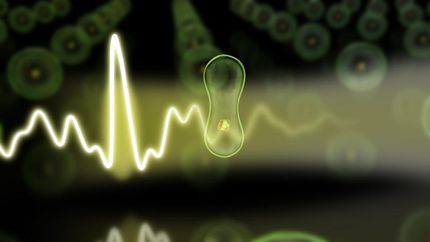Single electrons at top speed
Physicists control currents ten thousand times faster than high-speed electronics
At the University of Konstanz, the Chair for Ultrafast Phenomena and photonics succeeded in controlling the movement of single electrons on attosecond timescales. One attosecond is the billionth part of a billionth second. The electric field of ultrashort light pulses in this process determines how the electrons are being transported between two nanoelectrodes. The long-term goal is to optically control the current flow in new types of devices, and thus much faster than possible with current semiconductor technology.
Light is electromagnetic radiation whose electric and magnetic field oscillates with an extremely high frequency in the tera- and petahertz range – that is a trillion or thousand trillion oscillations respectively per second. In the successful experiment in Konstanz, extremely short light pulses spanning only a single oscillation cycle are focused on two electrodes, two metallic pathways pointing at each other without actually touching. The gap between the two is only eight nanometres wide. Using ultrashort light pulses, the Konstanz physicists managed the following: the single electrons race from one electrode to the other over the free-space gap. The metallic nanostructures were produced with the help of electron beam lithography, a high-tech process to create nano-structures. The resolution of the structures the researchers have achieved is at the limit set by this technology.
The ultrashort optical pulses have a duration of only one cycle of light. In this case it is relevant whether the strongest half-oscillation of the field is positive or negative. This fact can be used to change the direction the electrons are moving in. Today it is possible to control electric circuits with transistors nearly in the terahertz range. The idea underlying the technology used by the team around Dr Daniele Brida, head of the junior research group, and Professor Alfred Leitenstorfer is that light makes it possible to switch electrons ten thousand times faster – on a time scale of around one hundred attoseconds.
The Konstanz physicists developed and constructed the control instrument for the experiments, an extremely sophisticated laser technology, themselves. This system can create the extremely short pulses with a duration of only one light oscillation. Moreover, the researchers can exactly control the chronological sequence of the electric field of this light pulse. As a consequence, this allows to control whether the electron moves from the right to the left, or the other way round.
Original publication
Other news from the department science

Get the chemical industry in your inbox
By submitting this form you agree that LUMITOS AG will send you the newsletter(s) selected above by email. Your data will not be passed on to third parties. Your data will be stored and processed in accordance with our data protection regulations. LUMITOS may contact you by email for the purpose of advertising or market and opinion surveys. You can revoke your consent at any time without giving reasons to LUMITOS AG, Ernst-Augustin-Str. 2, 12489 Berlin, Germany or by e-mail at revoke@lumitos.com with effect for the future. In addition, each email contains a link to unsubscribe from the corresponding newsletter.



























































